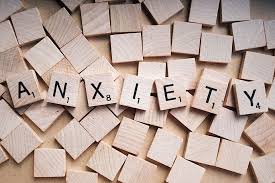Anxiety: How it develops and how to tame it.

How does Anxiety Develop?
The short answer is…it starts in the brain. There is a tiny, almond shaped part of the brain called the amygdala, located deep into the limbic system or what is commonly referred to as our “emotional brain." The emotional brain is the oldest, most primitive part of our brain, which was only ever designed to ensure physical survival.
Why would we need this?
Because long ago, physical safety was very important and a real problem. Think about cavemen who had to defend themselves against animals, reptiles, and other cavemen. Back then, humans needed a quick, hyper-vigilant brain that functioned automatically and unconsciously.
Now fast forward several centuries…our brains generally no longer need to have a heightened sense of physical safety to survive. Along the way, likely through evolution, the brain adapted to needs that are different in the modern world. Now, the brain doesn’t have to prepare for physical safety, but more for social or psychological survival.
So, how does this relate to anxiety?
One belief is that anxiety is related to a hyperactive amygdala. However, scientists have found that anxiety is the result of constant chatter between a number of different brain regions. They refer to this as a fear network (amygdala, hippocampus, and frontal lobe). In short, the frontal lobe, where thoughts and sensations come together, is the “thinking brain.” When that is overridden by the emotional brain, in this case the amygdala, anxiety happens.
Let me try to explain more…
When we sense danger is present (e.g., you hear screeching tires as you are crossing the street), the amygdala reacts automatically and activates the fight, flight, or freeze response. This allows us to quickly get out of harm’s way. While this is extremely helpful, what about when the fear isn’t physical or logical? The modern world is full of psychological stress, from big (traumatic events in the news, social media, natural disasters) to small (getting a shot, talking in front of a group, going to a party, etc.).
With these examples, we want to let our thinking brain run the show. The thinking brain (frontal lobe) processes information to determine if danger really is present and finds the most logical response to it.
In scenarios that present mild to moderate threats, the frontal lobe can override the amygdala and allow you to function (i.e., not have an anxiety attack). However, when a threat is perceived as strong, the amygdala acts automatically and can overpower the frontal lobe.
Remember the fear network? When we have a physiological response (increased heart rate, blood pumping to extremities, increased ability to take in oxygen) to a stimulus (fearful event, etc.), the hippocampus stores that into memory. So later when you feel the same or a similar physiological response, your brain thinks you are in actual danger and responds…sometimes causing a “false alarm."
How do you treat anxiety?
It’s not as simple as saying something positive! Remember, the amygdala fires automatically and unconsciously, meaning you cannot control that it fires or activates. You will experience physiological symptoms. Your goal is not let those symptoms overpower you.
Important note: The amygdala only learns when it is activated! That’s right, you have to feel anxious to be able to “teach” your brain to calm down. When you feel calm and are thinking about interventions to utilize, your amygdala isn’t learning a thing!
The amygdala isn’t trained by language, it is trained by actions!
Below are some steps to consider:
Acknowledge that you feel threatened or stressed and that your fight, flight, or freeze response has been activated. For kids, you may help label their feeling (scared, nervous, frightened…).
Once you acknowledge the amygdala is activated, then you can work to calm down or control it.
Remind yourself that the feeling is an automatic response, not necessarily the “right” or logical response.
Breathing cannot be underestimated! Take slow and deep breaths (using the diaphragm). It will take more than 3 to calm down! A simple trick to know if you are breaking correctly: when you inhale, your belly should go OUT…and when you exhale through your mouth, your belly should go IN. (You can also try placing a hand on your belly and a hand on your chest. The hand on your chest should not move, while the hand on your belly will go out and in.)
After breathing, now you can activate your thinking brain (frontal lobe).
Remember, the amygdala has to be activated for you to teach it new things! This is a part of exposure therapy. We have to approach the feared situation (meaning the amygdala is activated), stay until the physiological response has subsided, and then leave the situation. If you leave the situation before the body has calmed, you have only strengthened the amygdala’s response to that particular situation.
This is the time to think about the situation, develop logical solutions, change thoughts.
For instance, rather than thinking, “I can’t handle this, it is going to be awful.” Remind yourself “I’ve been here before; I can get through this.” Or “Feelings can’t last forever, this will end.”
Questions: Please contact Dr. Rose at DrRose@rosetherapycenter.com
